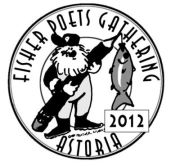 The 15th Annual Fisher Poets Gathering is underway in Astoria, Oregon. As the name suggests, it is a gathering where poets of the sea swap verse, music and stories. Men and women tied to the fishing industry share original poems, stories, songs, memoirs, essays and art in celebration of the work, its people and their concerns. The gathering runs through tomorrow at Clatsop Community College. Thanks to Darren O’Brien for pointing it out.
The 15th Annual Fisher Poets Gathering is underway in Astoria, Oregon. As the name suggests, it is a gathering where poets of the sea swap verse, music and stories. Men and women tied to the fishing industry share original poems, stories, songs, memoirs, essays and art in celebration of the work, its people and their concerns. The gathering runs through tomorrow at Clatsop Community College. Thanks to Darren O’Brien for pointing it out.
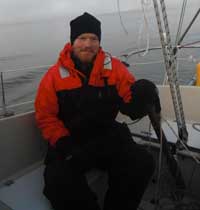 Matt Rutherford set out from Annapolis, Maryland last June 11th with an audacious goal. He intended to sail single-handed entirely around the Americas in a 27′ Albin Vega. He planned to sail a counterclockwise loop up the East Coast, cross the the Arctic via the Northwest Passage, sail down the Pacific Coast of North and South America, around Cape Horn and then back north again to the East Coast of the US. He has nearly made it. He is currently off the coast of Brazil. His problem now is that nearly everything on his boat is either broken or just worn out. He is planning a resupply stop off Recife, Brasil and he could really use donations for new parts. Click the link below to learn more and/or make a donation.
Matt Rutherford set out from Annapolis, Maryland last June 11th with an audacious goal. He intended to sail single-handed entirely around the Americas in a 27′ Albin Vega. He planned to sail a counterclockwise loop up the East Coast, cross the the Arctic via the Northwest Passage, sail down the Pacific Coast of North and South America, around Cape Horn and then back north again to the East Coast of the US. He has nearly made it. He is currently off the coast of Brazil. His problem now is that nearly everything on his boat is either broken or just worn out. He is planning a resupply stop off Recife, Brasil and he could really use donations for new parts. Click the link below to learn more and/or make a donation.
Upcoming Resupply, Matt needs your help
From the Washington Post: Annapolis sailor on unprecedented, around-the-Americas odyssey
Thanks to Fernando Costa for passing the news along.
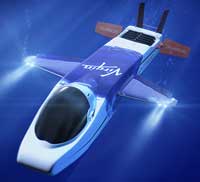
Virgin Deep Flight Challenger, submersible from one of possibly four attempts to return to the bottom of the Mariana Trench
Fifty two years ago, U.S. Navy Lieutenant Don Walsh and oceanographer Jacques Piccard dove to the bottom of the Mariana Trench in the bathyscaphe Trieste. They were the first, and so far, the only humans to have ventured to the deepest spot in all the the world’s oceans. Now three and possibly four teams are preparing to return to the depths of the Mariana Trench.
The vessels planning to return to the deepest place on earth include a three man submarine designed and built by Triton Submarines; a one man submarine, the Virgin Deep Flight Challenger, sponsored by Richard Branson’s Virgin Group, designed by Graham Hawkes, and to be piloted by Chris Welsh; and a submarine with a two or three man crew developed by DOER Marine. Hollywood director James Cameron is also understood to be preparing for a descent.
Continue reading
 Last week we posted about “Rum Running,” a new documentary which was broadcast last weekend on CBCs “Land and Sea.” It is now online and definitely worth watching. It is a fascinating look at when many sailors in Nova Scotia stopped fishing and became international smugglers during Prohibition in the US in the 1920’s and 30’s. Click here to watch the 21 minute documentary.
Last week we posted about “Rum Running,” a new documentary which was broadcast last weekend on CBCs “Land and Sea.” It is now online and definitely worth watching. It is a fascinating look at when many sailors in Nova Scotia stopped fishing and became international smugglers during Prohibition in the US in the 1920’s and 30’s. Click here to watch the 21 minute documentary.
The Penobscot Marine Museum in Searsport, Maine documents the rich and deep maritime history of the region and the town that was famous for its ship captains. The museum has a wonderful set of on-line, searchable, photography collections documenting the area’s ships, boats and the people who sailed them. One such collection is a series of close to 500 glass plate negatives from Ruth Montgomery, a sea captain’s daughter from Boothbay that document her life and travels.
The Ruth Montgomery Collection at the Penobscot Marine Museum
[iframe: width=”480″ height=”360″ src=”http://www.youtube.com/embed/tDvA3JLG8Kk” frameborder=”0″ allowfullscreen]
Continue reading

Seaborne rescue boat approaching drifting fishermen
The Pacific Ocean is indeed the world’s largest ocean. It is hard to grasp just how many fisherman from the myriad of islands in the Pacific become lost, are carried away by a storm, break down or run out of fuel and find themselves adrift on this vast ocean. This month we posted “US Army Landing Craft, Great Bridge, Rescues 101 Adrift in the Pacific,” and last November we posted, “Adrift in the Pacific – Two Kiribati Men Missing for 33 Days Come Ashore in Marshall Islands.” A year before we posted about “Three Teenagers Found Alive after Fifty Days adrift in Pacific Ocean.” One wonders how many are never found.
This Sunday, the Seaborne Odyssey rescued three fishermen adrift in the Pacific 150 miles southwest of Pago Pago, America Samoa. The fishermen had sailed from Apia in Western Samoa, had ran out of fuel and had been adrift for nearly three weeks. This is apparently the second rescue involving a Seabourn ship in less than a year.
Continue reading
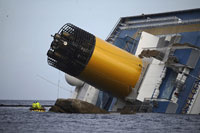
Photo: FILIPPO MONTEFORTE / AFP / GETTY IMAGES
The presumed death toll remains at 32 in the sinking of the Costa Concordia. Today divers located eight more bodies, bringing the number of known dead to 25 while the number of missing and presumed dead dropped to 7. Only three of the bodies; woman, a girl and a man, were removed from the ship due to worsening weather conditions. The bodies were taken ashore for identification, a process that can take several days. One of the bodies was identified, however, as Dayana Arlotti, who was five years old, the only young girl to be lost in the tragedy. Her father is still listed among the missing.
Divers in Italy Find Eight More Bodies at Costa Concordia Wreck
 Within the next day or so, two Spanish Air Force C-130 transport planes will land at Tampa’s MacDill Air Force Base to load 17 tons of gold and silver coins and other artifacts recovered from the wreck of the Spanish Navy’s Nuestra Senora de las Mercedes by Odyssey Marine. The 594,000 coins and other artifacts are valued at $500 million.
Within the next day or so, two Spanish Air Force C-130 transport planes will land at Tampa’s MacDill Air Force Base to load 17 tons of gold and silver coins and other artifacts recovered from the wreck of the Spanish Navy’s Nuestra Senora de las Mercedes by Odyssey Marine. The 594,000 coins and other artifacts are valued at $500 million.
In 1804, the British Royal Navy attacked a Spanish treasure fleet off Cape Santa Maria, Portugal, seizing £900,000 (equivalent to £62,923,000, or $98,638,000 today) in gold and silver. As the countries were not at war, Spain called the attack piracy, while the British justified as a “necessity of war.”
In 2007, Odyssey Marine salvaged 594,000 gold and silver coins from the wreck of the Nuestra Senora de las Mercedes, which exploded and sank during the battle in 1804. As the ship was a naval vessel, the Spanish sued Odyssey, demanding return of the treasure. After a five year legal battle, the Spanish have won. The coins and artifacts will finally make it to port after 208 years. The Battle of Cape Santa Maria is finally over. Thanks to Phil Leon for passing along the news.
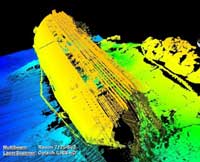 Video shot by a remotely operated vehicle (ROV), roughly a month after the ship ran aground, shows that the Costa Concordia is not sitting evenly on the bottom. Instead, the 950′ long ship is perched perilously on two rocky outcroppings at the bow and the stern. The rest of the ship’s hull is largely unsupported, except by its own buoyancy. This raises the possibility that the bending stresses on the hull may do serious structural damage and, in the worst case, break the ship in half.
Video shot by a remotely operated vehicle (ROV), roughly a month after the ship ran aground, shows that the Costa Concordia is not sitting evenly on the bottom. Instead, the 950′ long ship is perched perilously on two rocky outcroppings at the bow and the stern. The rest of the ship’s hull is largely unsupported, except by its own buoyancy. This raises the possibility that the bending stresses on the hull may do serious structural damage and, in the worst case, break the ship in half.
CONCORDIA COULD COLLAPSE UNDER ITS OWN WEIGHT
The problems do not end there however. The rocks on which the bow and stern are suspended are crumbling. The sandy bottom around the rocks and under the ship slopes at an angle of 20 degrees toward deep water. If the rocks that are now supporting the ship crumble further, it is possible that the ship might slip into deeper water.
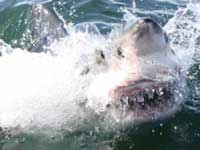 An inflatable fishing boat has survived an attack by a 7 meter long great white shark off Strandfontein, South Africa. The fisherman were fishing for smooth hound sharks, which great whites consider to be very tasty. As reported by IOL News: One of the passengers had just pulled a smooth hound on to the boat when a great white stuck its head out of the water and took hold of the side of the boat. The shark bit down, puncturing the boat, held on and thrashed for over a minute. The attack left a gash about half a metre long as well as a number of the shark’s teeth in the boat’s hull, which workers in Kalk Bay harbour admired on Monday.
An inflatable fishing boat has survived an attack by a 7 meter long great white shark off Strandfontein, South Africa. The fisherman were fishing for smooth hound sharks, which great whites consider to be very tasty. As reported by IOL News: One of the passengers had just pulled a smooth hound on to the boat when a great white stuck its head out of the water and took hold of the side of the boat. The shark bit down, puncturing the boat, held on and thrashed for over a minute. The attack left a gash about half a metre long as well as a number of the shark’s teeth in the boat’s hull, which workers in Kalk Bay harbour admired on Monday.
The inflatable boat, 8m long and 3m wide, and its seven passengers made it safely back to shore. Thanks to Phil Leon for passing the article along.
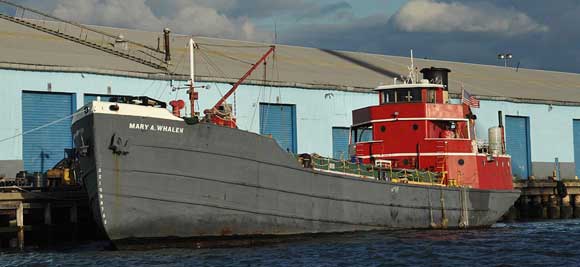 PortSide New York is one of the absolutely best waterfront educational organizations in New York harbor. Centered around the historic coastal tanker Mary A.Whalen, PortSide has sponsored a wide range of great programs ranging from activities for kids and adults, to hosting visiting tall ships, to shanty sings and even staging opera on the deck of the tanker. Now Portside is in trouble. For the last six years, the Mary A. Whalen has never had a permanent home. Now it needs to find one by April 30th. If not, the old tanker may be scrapped.
PortSide New York is one of the absolutely best waterfront educational organizations in New York harbor. Centered around the historic coastal tanker Mary A.Whalen, PortSide has sponsored a wide range of great programs ranging from activities for kids and adults, to hosting visiting tall ships, to shanty sings and even staging opera on the deck of the tanker. Now Portside is in trouble. For the last six years, the Mary A. Whalen has never had a permanent home. Now it needs to find one by April 30th. If not, the old tanker may be scrapped.
Continue reading

Admiral Washington?
In the United States, today is celebrated as Washington’s Birthday, also widely known as Presidents Day. On this the official day of celebration of his birthday, it seems worthwhile to look back on General George Washington’s navy of 1775 and 1776.
Washington was given command of the Continental Army on June 17th, 1775. The American army had surrounded and outnumbered the British army in Boston, but lacked both muskets, flints and gunpowder, as well as most other supplies. The British, on the other hand, were well supplied by sea. There were, however, fast schooners available in nearby Gloucester. Washington saw the opportunity to raid the British supply lines and supply his troops at the British expense.
In all Washington would send a total of eight armed schooners out to prey on British supply vessels. Oddly, these ships were neither privateers nor part of the as yet unformed Continental Navy. They were, instead, part of the Continental Army and in their 26 months of service, they would capture 55 enemy ships.
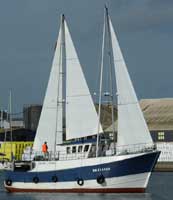 Two very interesting projects involving commercial sail from the Traditional Sail Professionals Linked-in Group. In Brittany, Avel Marine‘s Project Grand Largue is designing and testing auxiliary sailing rigs for existing fishing vessels. The design features a bipod mast and easily handled sails. The rig has been installed on two boats so far – the 16m 65 tonner wooden trawler Grand Largue and a former navy tug, Mango, with promising results. In a 15 – 20 knot wind the Grand Largue has achieved fuel savings of 43% fuel, at a speed of 7.4 knots and up to 35% at a speed of 8 knots.
Two very interesting projects involving commercial sail from the Traditional Sail Professionals Linked-in Group. In Brittany, Avel Marine‘s Project Grand Largue is designing and testing auxiliary sailing rigs for existing fishing vessels. The design features a bipod mast and easily handled sails. The rig has been installed on two boats so far – the 16m 65 tonner wooden trawler Grand Largue and a former navy tug, Mango, with promising results. In a 15 – 20 knot wind the Grand Largue has achieved fuel savings of 43% fuel, at a speed of 7.4 knots and up to 35% at a speed of 8 knots.
On the other side of the channel, the Sea-Change Sailing Trust‘s mission is to make “a real impact on the lives of disabled, disadvantaged and socially excluded young people.” They hope to do so through their programs sailing a cargo carrying Thames River barge. They currently charter a barge but are raising money to build a faithful replica of the steel Blue Mermaid, built in 1930.
The Cargo Carrying Thames Barge Under Sail – Our Vision, Our Philosophy
Continue reading
 These are busy days in ocean rowing. The Talisker Whisky Atlantic Challenge has finishing up and the Bouvet Guyane Solo Atlantic Rowing Race 2012 is well underway. There have been races across the Indian Ocean and races are scheduled for the Pacific. It is easy then to forget that before John Fairfax, who died this month at 74, rowed across the Atlantic in 1969, no one had ever done so alone. In 1972, he and his girlfriend, Syliva Cook, became the the first to row across the Pacific. Fairfax died, apparently of a heart attack on February 8th at this home in Henderson, Nev., near Las Vegas.
These are busy days in ocean rowing. The Talisker Whisky Atlantic Challenge has finishing up and the Bouvet Guyane Solo Atlantic Rowing Race 2012 is well underway. There have been races across the Indian Ocean and races are scheduled for the Pacific. It is easy then to forget that before John Fairfax, who died this month at 74, rowed across the Atlantic in 1969, no one had ever done so alone. In 1972, he and his girlfriend, Syliva Cook, became the the first to row across the Pacific. Fairfax died, apparently of a heart attack on February 8th at this home in Henderson, Nev., near Las Vegas.
John Fairfax, Who Rowed Across Oceans, Dies at 74
Continue reading
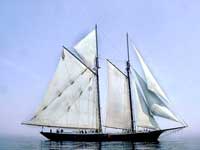 The schooner Ernestina, Ex. Effie M.Morrissey, was built in 1894 for the Gloucester fishing fleet. Under Captain Bob Bartlett she sailed to within 600 miles of the North Pole, and later brought immigrants to the U.S. under the power of sail. The schooner was designated as a National Historic Landmark in 1986 and is currently the official vessel of the Commonwealth of Massachusetts. The Ernestina is also in desperate need of repair.
The schooner Ernestina, Ex. Effie M.Morrissey, was built in 1894 for the Gloucester fishing fleet. Under Captain Bob Bartlett she sailed to within 600 miles of the North Pole, and later brought immigrants to the U.S. under the power of sail. The schooner was designated as a National Historic Landmark in 1986 and is currently the official vessel of the Commonwealth of Massachusetts. The Ernestina is also in desperate need of repair.
Continue reading
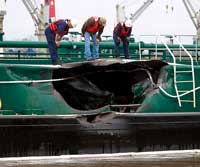 Three stories this weekend of oil spills, a successful oil transfer and opportunities lost in mitigating a spill. Two barges collided on the Mississippi River on Friday upriver from New Orleans. A roughly 3,500 barrel capacity double hulled tank barge suffered damage and was reported to have spilled an estimated 10,000 gallons (238 barrels) of crude oil into the river. The Coast Guard closed a five mile stretch of the river on Friday but have begun to reopen it this morning. The spill is reported to be contained.
Three stories this weekend of oil spills, a successful oil transfer and opportunities lost in mitigating a spill. Two barges collided on the Mississippi River on Friday upriver from New Orleans. A roughly 3,500 barrel capacity double hulled tank barge suffered damage and was reported to have spilled an estimated 10,000 gallons (238 barrels) of crude oil into the river. The Coast Guard closed a five mile stretch of the river on Friday but have begun to reopen it this morning. The spill is reported to be contained.
Continue reading
 Looking slightly like a miniature Costa Concordia, the 60.2 meter (197′) French yacht Yogi rolled and sank after reporting a ‘mechanical failure’ in high seas and Force 8 winds on Friday. The yacht sank between the islands of Skyros and Psara, 19 nautical miles off the coast. Greek Coast Guard vessels supported by two Air Force helicopters, a Navy frigate, and four commercial ships headed to the assist the yacht after its captain sent out a distress signal. Eight people aboard the Yogi were airlifted to safety by Greek Super Puma helicopters. The yacht Yogi was less than a year old, having been built at the Proteksan Turquoise Shipyard in Istanbul, Turkey in 2011.
Looking slightly like a miniature Costa Concordia, the 60.2 meter (197′) French yacht Yogi rolled and sank after reporting a ‘mechanical failure’ in high seas and Force 8 winds on Friday. The yacht sank between the islands of Skyros and Psara, 19 nautical miles off the coast. Greek Coast Guard vessels supported by two Air Force helicopters, a Navy frigate, and four commercial ships headed to the assist the yacht after its captain sent out a distress signal. Eight people aboard the Yogi were airlifted to safety by Greek Super Puma helicopters. The yacht Yogi was less than a year old, having been built at the Proteksan Turquoise Shipyard in Istanbul, Turkey in 2011.
Continue reading

HMCS Corner Brook
Canadian Submarine HMCS Corner Brook ran aground during manoeuvres off Vancouver Island in June 2011. Two sailors were slightly injured. The Canadian navy never described the extent of the damage or released a photograph of the damage to the sub. The sub has now just been drydocked for repairs. Canadian Senator Colin Kenny, the former head of the Senate defence committee, commented that “I was gobsmacked. I had no idea that this level of damage had occurred,” describing the damage to the sub as “horrific.”
Continue reading
We have previously posted about the CBC’s “Land and Sea,” a program which for thirty years has been focussed on stories from people who live off the land and the sea on the Canadian Atlantic. In December, they featured a wonderful documentary on Nova Scotia Schooners. This Sunday, February 19th, Land & Sea will broadcast Rum Running, a documentary by Tell Tale Productions, which looks fascinating.
[iframe: width=”560″ height=”315″ src=”http://www.youtube.com/embed/zbclESshR6M” frameborder=”0″ allowfullscreen]
Continue reading
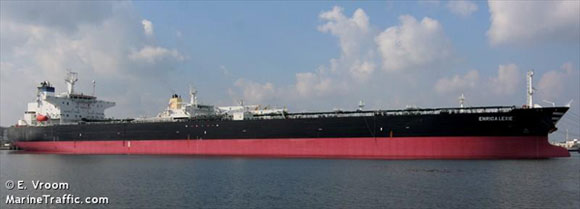
Enrica Lexie
Armed guards, reported to be Italian naval personnel, on the tanker, Enrica Lexie, fired on and killed two Tamil Nadu fishermen off Kochi on Wednesday, believing the fishermen to be pirates. Indian authorities said the Italian guards fired without warning in violation of international anti-piracy guidelines – a claim denied by Italy. Charges of murder have been filed.
